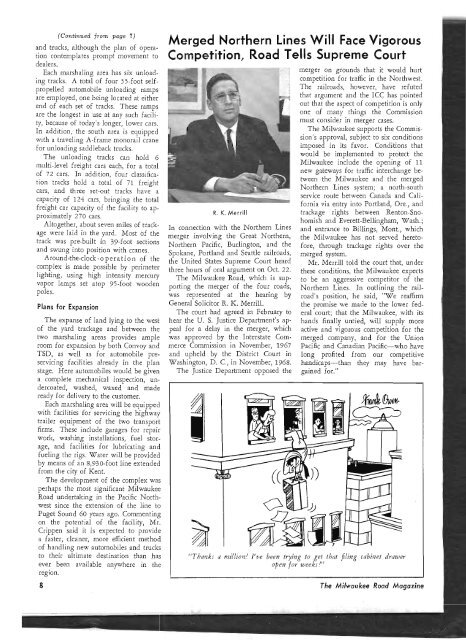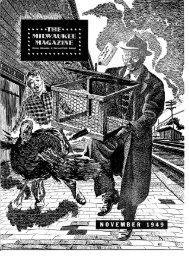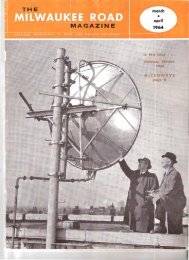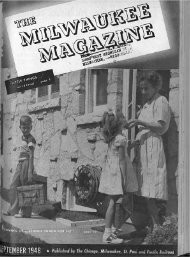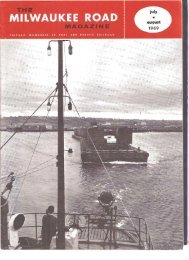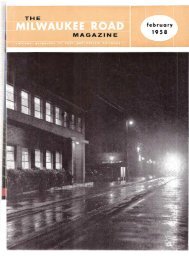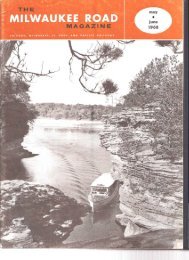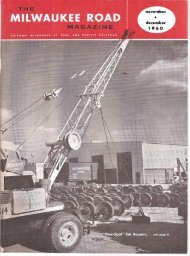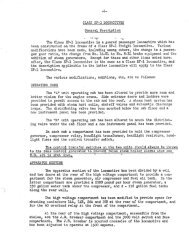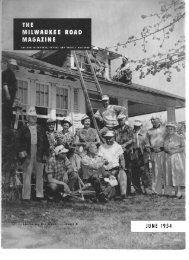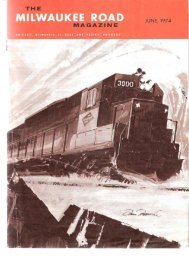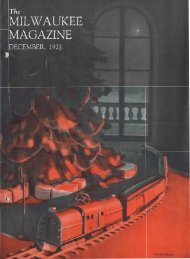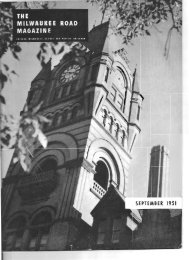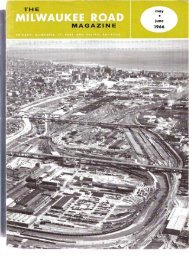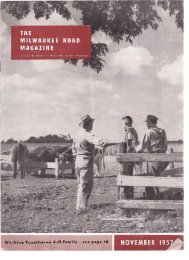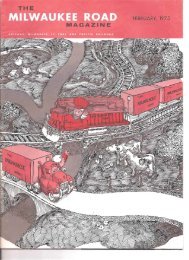November-December, 1969 - Milwaukee Road Archive
November-December, 1969 - Milwaukee Road Archive
November-December, 1969 - Milwaukee Road Archive
Create successful ePaper yourself
Turn your PDF publications into a flip-book with our unique Google optimized e-Paper software.
(Continued from page 7)<br />
and trucks, although the plan of operation<br />
contemplates prompt movement to<br />
dealers.<br />
Each marshaling area has six unloading<br />
tracks. A total of four 55-foot selfpropelled<br />
automobile unloading ramps<br />
are employed, one being located at either<br />
end of each set of tracks. These ramps<br />
are the longest in use at any such facility,<br />
because of today's longer, lower cars.<br />
In addition, the south area is equipped<br />
with a traveling A-frame monorail crane<br />
for unloading saddleback trucks.<br />
The unloading tracks can hold 6<br />
multi-level freight cars each, for a total<br />
of 72 cars. In addition, four classification<br />
tracks hold a total of 71 freight<br />
cars, and three set-out tracks have a<br />
capacity of 124 cars, bringing the total<br />
freight car capacity of the facility to approximately<br />
270 cars.<br />
Altogether, about seven miles of trackage<br />
were laid in the yard. Most of the<br />
track was pre-built in 39-foot sections<br />
and swung into position with cranes.<br />
Around-the-clock -0 perat ion of the<br />
complex is made possible by perimeter<br />
lighting, using high intensity mercury<br />
vapor lamps set atop 95-foot wooden<br />
poles.<br />
Plans for Expansion<br />
The expanse of land lying to the west<br />
of the yard trackage and between the<br />
two marshaling areas provides ample<br />
room for expansion by both Convoy and<br />
TSD, as well as for automobile preservicing<br />
facilities already in the plan<br />
stage. Here automobiles would be given<br />
a complete mechanical inspection, undercoated,<br />
washed, waxed and made<br />
ready for delivery to the customer.<br />
Each marshaling area will be equipped<br />
with facilities for servicing the highway<br />
trailer equipment of the two transport<br />
firms. These include garages for repair<br />
work, washing installations, fuel storage,<br />
and facilities for lubricating and<br />
fueling the rigs. Water will be provided<br />
by means of an 8,930-foot line extended<br />
from the city of Kent.<br />
The development of the complex was<br />
perhaps the most significant <strong>Milwaukee</strong><br />
<strong>Road</strong> undertaking in the Pacific Northwest<br />
since the extension of the line to<br />
Puget Sound 60 years ago. Commenting<br />
on the potential of the facility, Mr.<br />
Crippen said it is expected to provide<br />
a faster, cleaner, more efficient method<br />
of handling new automobiles and trucks<br />
to their ultimate destination than has<br />
ever been available anywhere in the<br />
region.<br />
g<br />
Merged Northern Lines Will Face Vigorous<br />
Competition, <strong>Road</strong> Tells Supreme Court<br />
R. K. Merrill<br />
In connection with the Northern Lines<br />
merger involving the Great Northern,<br />
Northern Pacific, Burlington, and the<br />
Spokane, Portland and Seattle railroads,<br />
the United States Supreme Court heard<br />
three hours of oral argument 'On Oct. 22.<br />
The <strong>Milwaukee</strong> <strong>Road</strong>, which is supporting<br />
the merger of the four roads,<br />
was represented at the hearing by<br />
General Solicitor R. K. Merrill.<br />
The court had agreed in February to<br />
hear the U. S. Justice Department's appeal<br />
for a delay in the merger, which<br />
was approved by the Interstate Commerce<br />
Commission in <strong>November</strong>, 1967<br />
and upheld by the District Court in<br />
Washington, D. C, in <strong>November</strong>, 1968.<br />
The Justice Department opposed the<br />
merger on grounds that it would hurt<br />
competition for traffic in the Northwest.<br />
The railroads, however, have refuted<br />
that argument and the ICC has pointed<br />
'Out that the aspect of competition is only<br />
one of many things the Commission<br />
must consider in merger cases.<br />
The <strong>Milwaukee</strong> supports the Commission's<br />
approval, subject to six conditions<br />
imposed in its favor. Conditions that<br />
would be implemented t-o protect the<br />
<strong>Milwaukee</strong> include the opening of 11<br />
new gateways for traffic interchange between<br />
the <strong>Milwaukee</strong> and the merged<br />
Northern Lines system; a north-south<br />
service route between Canada and California<br />
via entry into Portland, Ore., and<br />
trackage rights between Renton-Snohomish<br />
and Everett-Bellingham, Wash.;<br />
and entrance to Billings, Mont., which<br />
the <strong>Milwaukee</strong> has not served heret-ofore,<br />
through trackage rights over the<br />
merged system.<br />
Mr. Merrill told the court that, under<br />
these conditions, the <strong>Milwaukee</strong> expects<br />
to be an aggressive competitor of the<br />
Northern Lines. In outlining the railroad's<br />
position, he said, "We reaffirm<br />
the promise we made to the lower federal<br />
court; that the <strong>Milwaukee</strong>, with its<br />
hands finally untied, will supply more<br />
active and vigorous competition for the<br />
merged company, and for the Union<br />
Pacific and Canadian Pacific-who have<br />
long profited from our competitive<br />
handicaps-than they may have bargained<br />
for."<br />
"Thanks a million l I've been trying to get that filing cabinet drawer<br />
open jor weeks!"<br />
The <strong>Milwaukee</strong> <strong>Road</strong> Magazine


